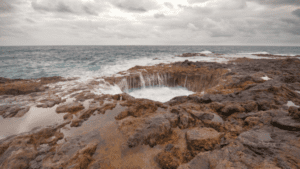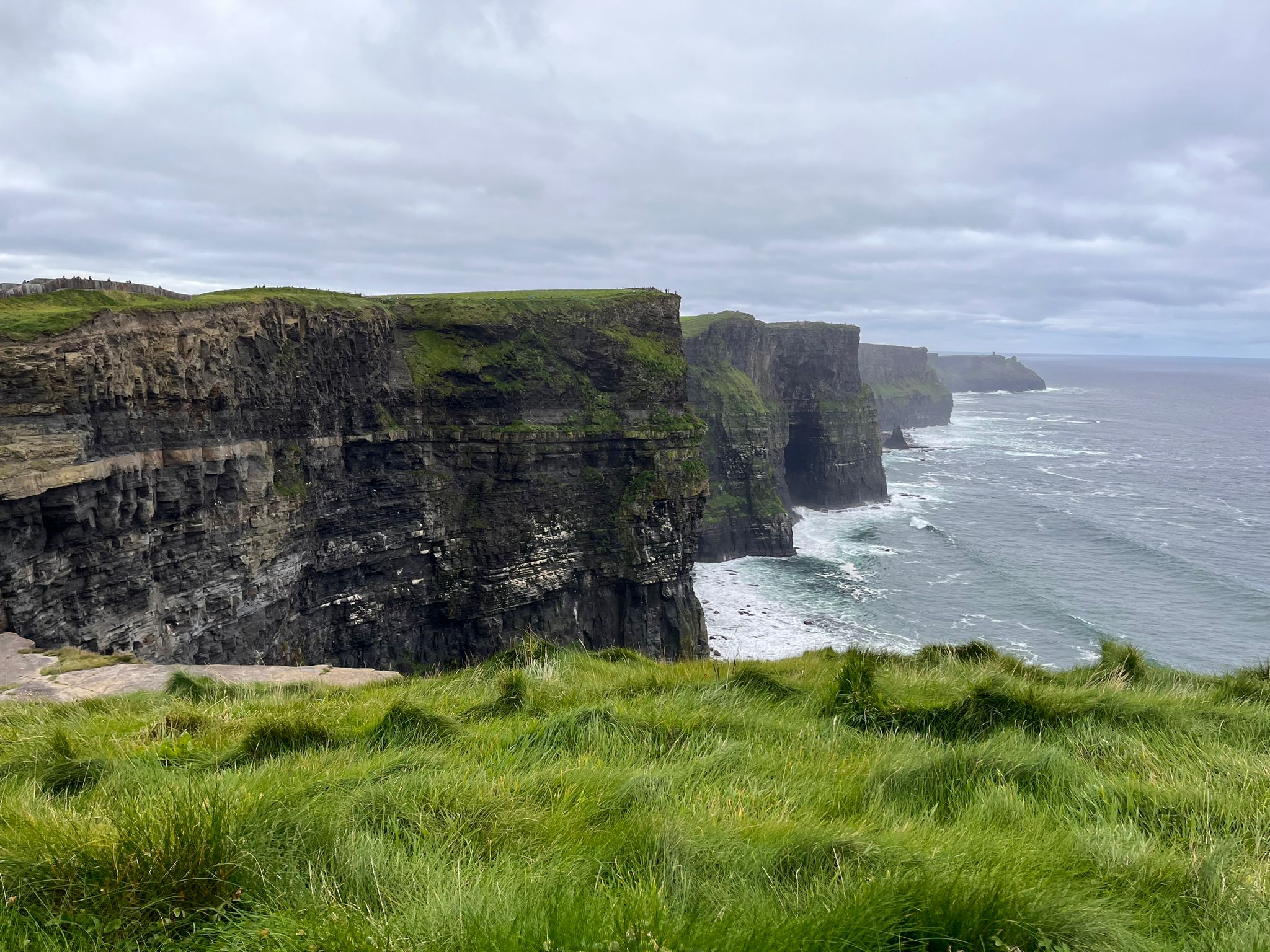
Introduction
Coastal features are of various types of physical features situated along the coastline or shoreline of a sea or ocean. Coastal landforms are the result of dynamic interaction of processes like erosion, deposition, and other geological agents. They are formed either by the deposition of sediments along the coastline, forming depositional features, or the carrying away of sediments by waves and ocean currents forming coastal erosional features.
Aspects of Coastal Landforms
- Coastal landforms are dynamic and ever-changing.
- They are formed through various geological processes like erosion, deposition, etc.
- Are very susceptible to vulnerabilities.
- Coastal landforms are highly diverse starting from beaches to cliffs etc.
Importance of Coastal Landforms
A few points to highlight about the importance of coastal landforms are-
- They provide critical habitats for a variety of marine and terrestrial flora and fauna.
- They are economically very important as they support the fishery, tourism, etc.
- Coastal landforms act like a barrier during storm surges.
- Coastal features like mangroves control climate change.
- They have cultural and historical importance.
Types Of Coastal Features
There are various types of coastal erosional and depositional landforms present on Earth’s surface, some of them are-
Cliffs
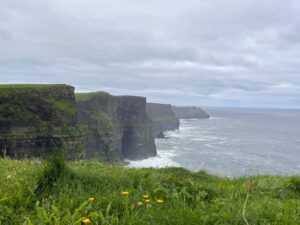
A scrap face of the coast facing the sea is known as a sea cliff. They are steep-sided vertical walls like rock beds on the sea. In the beginning, the sea waves cut a groove in the rock at sea level which is known as notch. This notch keeps on widening with the passage of time. It thus undermines the overhanging rock until it falls into the sea and forms a cliff. Examples are the Cliffs of Moher, County Clare, Ireland.
Beaches
A beach is formed due to the deposition of sand, gravel, and pebbles on the shore between the low tide level and the coastline. A beach grows in size when waves are less active but it may be completely destroyed by strong waves in a storm. Examples are Waikiki beach, Hawaii, USA, and Bondi beach, Australia.
Dunes
Coastal dunes are also called marine dunes. Sand dunes of various sizes occur in coastal areas in many parts of the world. Sand carried by sea waves is deposited along the coast and sand dunes are formed. Some sand washed by the sea waves is blown by winds and is deposited to form dunes. Such dunes gradually migrate inland. The occurrence of large tracts of unconsolidated sand and strong onshore winds favor the formation of dunes along the coast. Examples are the Dune fields of Coos Bay, Oregon.
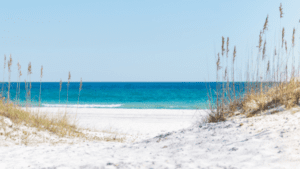
Estuaries
An estuary is a partially enclosed coastal body of brackish water with one or more rivers or streams flowing into it and with a free connection to the open sea. Estuaries form a transition zone between river environments and maritime environments. Examples are the Columbia River Estuary, North America, and Lagoa Dos Patos, South America.
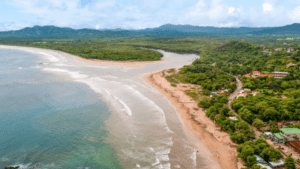
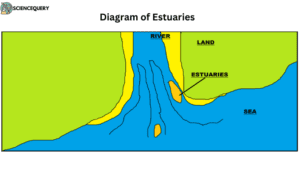
Coastal erosion
The erosional work of the sea depends upon the size and the strength of waves, sea slope and height of the shore, etc. sea waves operate as an agent of erosion in the following ways-
1. Hydraulic action
it involves the picking up of loose materials by waves, and the shattering of rocks as the waves crash like giant water, hammers against the cliffs.
2. Abrasion
When the waves, armed with rock fragments, hurl themselves against the cliffs and co-operating with currents, drag them to and fro across the rocks of the foreshore.
3. Attrition
The rock fragments or tools of the aves strike against each other and are reduced, this is attrition.
4. Solution
The solvent rocks such as limestone, dolomite, and chalk are dissolved by the solution action of sea waves.
Important coastal erosional landforms
- Sea-cliff
- Wave cut platform
- Sea caves
- Natural ridges
- Stack
- Stumps
- Blow-holes
- Geo
- Coves
- bays
Role of nature in shaping coastal erosional landforms
- Waves generated by wind and ocean currents are a primary force of nature responsible for coastal erosion.
- Tides, caused by the gravitational pull of the moon and sun, influence coastal erosion by changing water levels.
- Severe storms, hurricanes, and tsunamis deliver massive amounts of sediments to the coastline.
- Coastal ecosystems such as coral reefs can influence erosion by providing natural barriers (1).
Role of human
- High levels of tourism and recreation activities in coastal areas lead to the trampling of dunes and vegetation.
- Pollution from urban runoff, industrial discharges, and agricultural runoff can harm coastal ecosystems.
- Overfishing leads to disruption in marine food webs and reduces the population of species.
- Rising sea level due to global warming contributes to increased coastal erosion (2).
Coastal deposition
Depositional coasts are generally found along the coastline of gentle relief, where sediments from various sources are available. Depositional features are also created by the stocking and inundation of sediments along the coastline during storms.
Important coastal depositional landforms
- Sea-beaches
- Bars and barriers
- Offshore and longshore bars
- Spits
- Hook
- Loops
- Connecting bars
- Tombolo
- Barrier island
- Tidal inlets
- Wave-built platforms
Impact
- Coastal depositional landforms act as natural barriers against coastal erosion and storm damage.
- These landforms create important habitats for various plant and animal species.
- They act as nursery areas for juvenile fish and other aquatic organisms.
- Sandy beaches and dunes are major tourist spots all across the world.
- They support various economic activities like fishing, tourism, boating, etc.
- Coastal depositional landforms have huge cultural and historical significance (3).
Unique Coastal Formation
Sea stacks

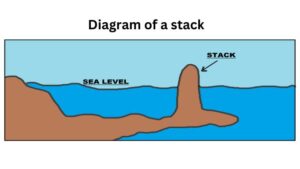
Stacks are isolated rock pillars rising steeply from the sea. Formerly stacks were part of the adjoining land, but have become isolated from it by wave erosion. Examples are The Needles off the Isle of Wight, England. The Old Harry Rocks off the Isle of Purbeck, South England.
Blow holes
A blow hole forms when the roof of a sea cave at the landward end of a geo may communicate with the surface by way of a vertical shaft at some distance from the edge of a cliff. It is like a natural chimney. Examples are The Devil’s Bridge, Scotland.La Bufadora,Baja California,Mexico.
Sea caves
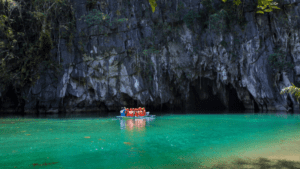
Softer rocks at the base are quickly eroded away when the sea waves dash against the rock. They widen joints and cracks and ultimately build up holes and hollows called sea caves. Examples are Famous Fingal’s Cave on a small island. Staffa of Iner Hebrides of Scotland.
Human interaction and its influence
- Urbanization and infrastructure: the construction of buildings, roads, ports, and other infrastructure in coastal areas can disrupt natural sediment transport and coastal processes.
- Coastal armoring: seawalls, revetments, and breakwaters built on coasts disrupt natural sediment transport.
- Deforestation and wetland destruction: clearing coastal forests and wetlands for agriculture or development can reduce the natural protection these ecosystems provide against erosion.
- Climate change and sea level rise: human-induced climate change, primarily through greenhouse gas emissions, is causing sea levels to rise at a high rate. Rising sea level leads to coastal erosion.
- Pollution: pollution from urban runoff, industrial discharges, and agricultural runoff can harm coastal ecosystems.
- Tourism and recreation: high levels of tourism and recreational activities lead to the trampling of dunes, vegetation, etc.
- Overfishing: it disrupts marine food webs and reduces populations of species that play an important role in maintaining healthy coastal life (4).
Conservation efforts
- Protect natural vegetation: preserve coastal vegetation, such as dunes, mangroves, salt marshes, and seagrass beds.
- Coastal armoring reduction: minimizing the use of hard coastal structures like seawalls and revetments, which disrupt natural sediment transport.
- Beach nourishment: when needed, usage of beach nourishment projects to replenish eroding beaches with sand from approved sources.
- Managing stormwater runoff: implementing stormwater management practices to reduce pollution from urban runoff.
- International cooperation: recognizing the interconnectedness of coastal areas across national boundaries and engaging in international cooperation.
- Education and raising awareness: educating the public, tourists, communities, and decision-makers about the importance of coastal landforms (5).
Q&A
1. What are coastal features?
Coastal features or coastal landforms are any type of relief features present along any coast, the result of a combination of processes like erosion and deposition of sediments.
2. What are the three coastal features?
The three major coastal features are-
- Beaches
- Sea caves
- Cliffs
3. What are the four features of coastal erosion?
The four important coastal erosional features are-
- Sea cliff
- Sea cave
- Bay
- Hanging valley
Summary
- Coastal landforms are diverse and dynamic coastal features found along the coastlines.
- They play vital roles in shaping coastlines, supporting ecosystems, and impacting human activities.
- They are of great ecological, economic, and cultural significance.
- Coastal landforms are of two types- erosional and depositional.
- Coastal landforms are vulnerable to the impacts of climate change, pollution, and coastal development.
- Proper management and conservation efforts are essential to preserve these valuable coastal features and the ecosystems they support.
References
- D.S Lal.Physical Geography. Sharda Pustak Bhawan,Allahabad. Chapter 18: Landforms shaped by waves and currents, PP: 221-237.
- D.R.Khullar.ISC Geography.Kalyani Publishers, Kolkata. Chapter 15: Marine processes and associated landforms, PP: 222-232.
- Savindra Singh.Geomorphology.Pravalika Publications, Allahabad. Chapter 24: Coastal Geomorphology, PP: 447-462.
- Arun Shankar pal.Higher secondary Geography.New Book Syndicate, Kolkata. Chapter 3: Marine processes and associated landforms, PP: 20-28.
- Anuj Baran Sarkar.Higher secondary Geography.Oriental Book Company Pvt. Ltd., Kolkata. Chapter 1.3.4-Work of waves, PP: 17-26.



